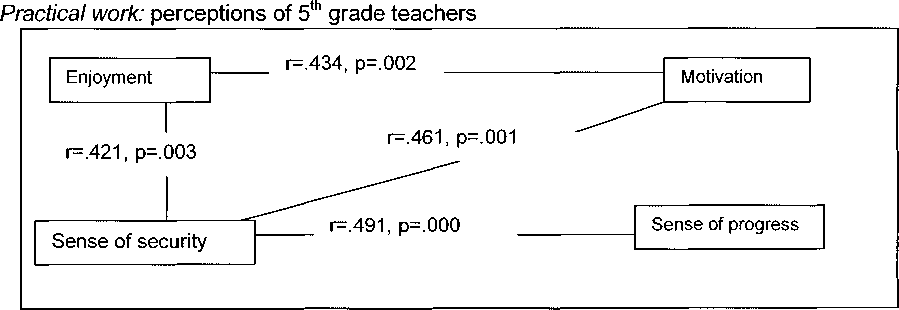157
believed that the teaching method might promote one aspect but not others. The
relationships between pupils’ attitudinal aspects promoted by individual teaching
methods and the deployment of particular teaching methods are also examined. The
examination is conducted among the responses of 5th grade teachers, 8th grade
teachers, 5th graders and 8th graders, separately.
Practical work
As illustrated in Figure 4.5.1, there were significant moderate positive correlations
among the responses of 5th grade teachers to the effects of practical work on pupils’
enjoyment and motivation, enjoyment and sense of security, motivation and sense of
security, sense of security and sense of progress. Overall, Practical work was perceived
as being relatively coherent in its effects on attitudes towards mathematics.
Figure 4.5.1 Relationships between attitudes to mathematics learning as promoted by

There were significant moderate positive correlations among the responses of 8th grade
teachers between enjoyment and motivation, and motivation and sense of security as
perceived to be promoted by Practical work. Practical work was perceived as promoting
enjoyment, motivation and sense of security together but sense of progress was
perceived as being unrelated to other facets (see Figure 4.5.2). This pattern shows less
cohesion than that of the 5th grade teachers.
157
More intriguing information
1. The name is absent2. Retirement and the Poverty of the Elderly in Portugal
3. Short- and long-term experience in pulmonary vein segmental ostial ablation for paroxysmal atrial fibrillation*
4. Growth and Technological Leadership in US Industries: A Spatial Econometric Analysis at the State Level, 1963-1997
5. The name is absent
6. Tariff Escalation and Invasive Species Risk
7. The name is absent
8. The name is absent
9. The Global Dimension to Fiscal Sustainability
10. Conflict and Uncertainty: A Dynamic Approach